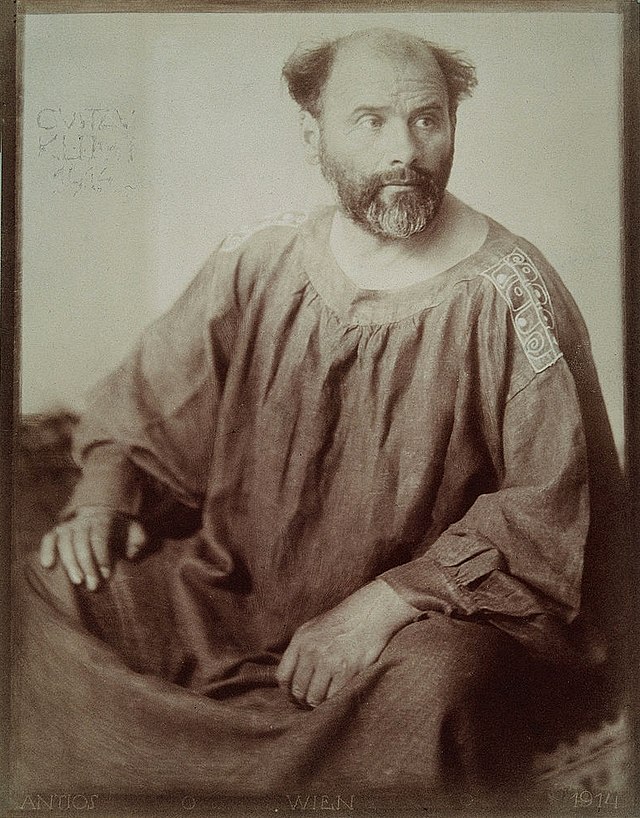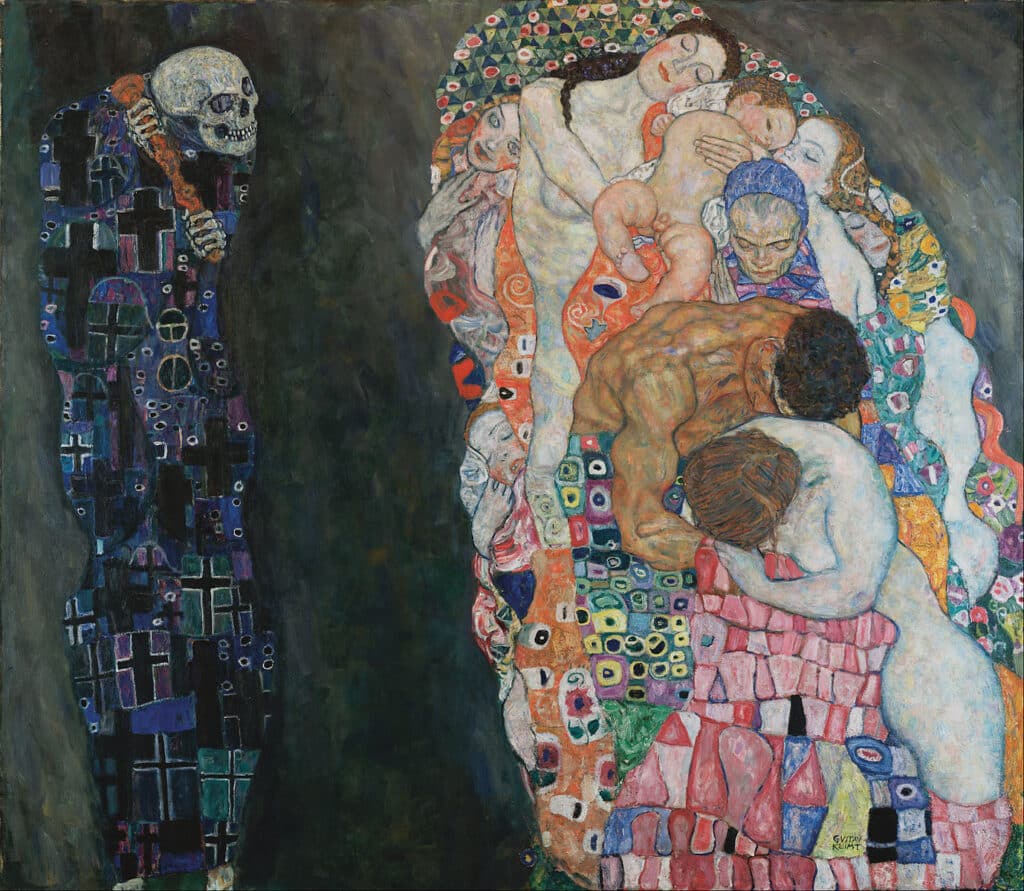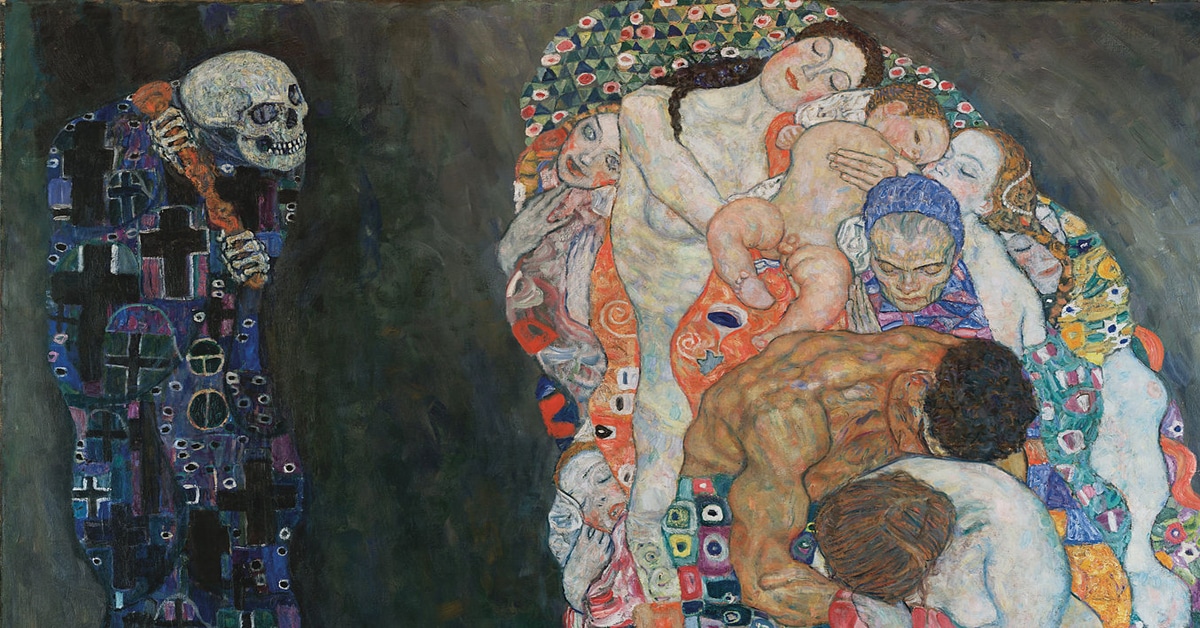Gustav Klimt is a well-known artist who managed to create paintings that are significantly important to today’s art world. One of the most recognizable paintings in all of art history is his piece “The Kiss.” His work promoted Austrian art as a key player in the Vienna Secession. One of their most impressive symbolic paintings created by him is “Death and Life.”
Throughout his lifetime, Klimt produced a number of artworks, however, they were not released until many years after his passing. This painting emphasized the feminine form, sensuality, and love. “Death and Life” includes all those attributes. However, it is much more than that. Below, you will find a description, history, and analysis of the Death and Life painting.
Brief Biography Of Gustav Klimt
Before exploring the painting “Death and Life,” let’s first learn more about the author. Gustav Klimt is among the most famous Australian artists. He was born in Baumgarten on July 14, 1862, as the first child of Anna and Ernst Klimt. His siblings were Berta, his sister, and two brothers who passed away soon after birth. His father had a prosperous construction firm that built railroad bridges and worked in the mining industry.
Even though there is considerable controversy about whether he received any official artistic education, he started drawing when he was a little boy. Gustav Klimt claimed to have taken some classes in 1876, and some question whether or not his reports of his schooling are totally authentic. Gustav experienced financial success, which allowed him to pursue a fine arts education later on.
Gustav Klimt studied architecture, painting, and sketching at the Vienna School of Arts and Crafts in 1876. Due to his father’s passing two years later, he stopped attending school. However, he created a number of well-known works of art before leaving school, including Birdman (1891). After he finished school, he started concentrating on his painting. There are more than 100 paintings by Klimt that are well-known.
In 1877, together with their friend Franz Matsch, the two brothers (Klimt and Ernst) started their collaborative work. By 1880, they had won several projects under the name “Company of Artists.” On the Ringstraße, Klimt began his professional painting career by creating interior murals and ceilings for major public structures, including a popular series of “Allegories and Emblems.”
In 1897, Klimt joined the Wiener Secession (Vienna Secession) and was elected its president. He also served as editor-in-chief of the group’s journal, Ver Sacrum (Sacred Spring). He remained a member of the Secession until 1908. The club set out to create its own journal to highlight the work of its members, arrange exhibits for young, unusual artists, and bring the greatest international artists’ works to Vienna.
Naturalists, realists, and symbolists all coexisted in the organization. The government assisted them and granted them a lease on public property so they could build an exhibition hall. Pallas Athena, the Greek goddess of righteous causes, knowledge, and the arts, served as the group’s emblem. Klimt created his avant-garde interpretation of Pallas Athena while being in the secession in 1898.

Death and Life
Gustav Klimt painted Death and Life on canvas between 1910 and 1915. It is now housed in Vienna’s Leopold Museum. The picture has the keyword allegory, and death in art with women is also highly symbolic. Since he doesn’t think twice about putting undiluted oils on the canvas, his colors are also meaningful.
Death and Life, which Klimt regarded as his most significant piece of figurative art, earned him the praise necessary to support that assertion. After taking first prize at the 1911 International Art Exhibition in Rome, the artwork was displayed in Dresden, Budapest, Mannheim, Prague, Berlin, Stockholm, Copenhagen, Zurich, and Vienna over the following twelve years. In the 1960s, it eventually managed to reach New York and London.
And it should not be surprising that it is popular. The intertwined statuesque reaper and life figures are about six feet tall and literally dazzle in Klimt’s characteristic riot of color and design. This piece of art is very unique because it depicts every step of a person’s life. The characters include a newborn in his mother’s arms, a youngster, a teenager, a strong, mature man, and a wise lady wearing a blue cap. In a spectacular jumble of color and energy, death, clad in crucifixes, is also visible to the side.
Klimt has always used color to create contrast in his paintings, and “Death and Life” is no exception. Deep tones are utilized to depict Death, who is holding a weapon that may be used to kill anyone. It looks at a group of people to the viewer’s right who come from various racial and ethnic origins. In “Death and Life,” Klimt, a Symbolist painter, makes multiple allusions to diverse themes by mixing various symbols with the individuals. Death looks at everything as a whole, evaluating young adults, kids, and the hidden things they symbolize.
Bright colors were utilized to depict life, and in one area, flowers appeared to be just beginning to blossom. Around the circle of life are other circular decorations. They embellish it and mark out the beauty that endures even under the worst circumstances.
Klimt used a conventional picture by using a skeleton in this representation as the sign of death. Klimt’s Death, on the other hand, is dressed elegantly in what nearly appears to be a costume and is beautifully embellished with crosses.
In contrast to the melancholy Death group, the Life group is upbeat. The populace is surrounded by a vibrant profusion of ornamentation. Klimt playfully conceals and exposes the characters, alternating between exposed body portions and beautiful islands of color. The cycle of life is represented by the couple in love, the mother and her little kid, and the elderly person. They continue to exist in a somnambulistic, passive condition and appear resistant to Death’s presence. They are unable to halt his obstinacy.

Symbolism in “Death and Life”
Skulls are amusing in some ways. Once the shock of seeing a skinless, eyeless head wears off, take note of the grin. Doesn’t it have a hint of humor? Gustav Klimt must have seen the goofy side of the human psyche since his massive painting Death and Life has a personification of death that positively hums with odd charm.
Death and Life are the two main components of this picture, with Death on the left and Life on the right. While the delicate female picture depicts life in all its purity and beauty, the grim reaper stands for the artwork’s negative qualities.
Death and Life feel real and upbeat despite the melancholy gray addition. Since death is the natural conclusion to everything, it may have been called “Life and Death.” In this dark ocean, death may come, but life will always exist.
The floral patterns in The Kiss and the combination of generations in Three Ages of Woman are just two examples of the many characteristics that describe a life that can be seen throughout his body of work. Death and Life feature various depictions of women, which Klimt liked and used as a way to symbolize life. The two facets of existence that appealed in the art were the use of nature and women figures together.
Gustav Klimt’s Death and Life Painting is unsettling. The artist addresses a subject that many people find frightening. He carefully considered where each component should be placed in the picture, moving the viewer’s attention from one topic to another as he delivered his tale. The two-part picture serves as a reminder that Life is constantly being monitored with some degree of malice. Any age group may relate to this. In the artwork, older and younger men and women are seen, seemingly oblivious to the possibility of death striking at any time.
Klimt’s figures in the circle serve as a reminder that even if death befalls one, the others will go on and prosper. His methods have taken chilling shapes. Death is brash and impressive. Its goals are not covert or ambiguous.
The figurative images Klimt used in his earlier faculty painting “Medicine” are evocative of the “Life group” part of “Death and Life”. “Medicine” was created to adorn the University of Vienna’s festival chamber together with the other two faculty paintings. However, this never happened.

Changes in the Painting
“Death and Life,” according to Gustav Klimt, is his most significant figurative work. The original painting had a golden background similar to Adele Bloch-Bauer. Even five years after it was finished in 1910, he was still not happy with it. In the end, he made the initial gold background gray. He further embellished both Death and Life with additional metaphorical embellishments.
Bottom Line
As you can see, because of how striking Klimt’s aesthetic is, the peculiar composition really conceals itself.
Klimt’s use of symbolism in Death and Life is overt and sudden, making it a usually approachable piece of art. The use of undiluted oils applied directly to the canvas and an intense color palette are typical for his artworks. Few people will be able to miss the artist’s message in this picture, which perfectly shows the cycle of life.
